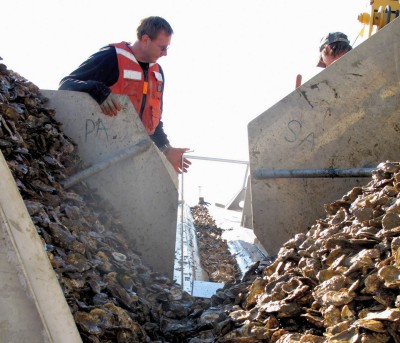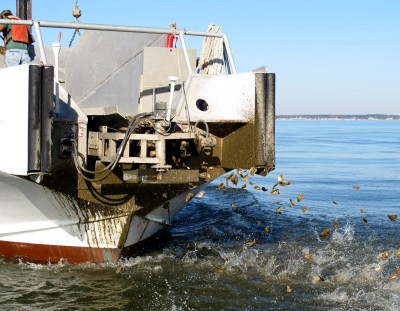
A Chesapeake Bay Foundation boat places hatchery-produced seed oysters on a sanctuary reef, made of concrete from a demolished dam, on Nov. 7. (Photo: Greg Masters)
ANNAPOLIS (December 09, 2011)—The Chesapeake Bay's oyster population has plummeted since the late 1960s, when Willy Dean, a Maryland waterman since the age of 17, would go hand tonging with his father and "load the boat with oysters."
"The catch is way, way down from what it was back then," Dean said.
The population is so low that several scientists recommended a complete halt on oyster harvesting in a study published in August by the University of Maryland Center for Environmental Science. But a moratorium has not gained traction among watermen and state officials, who see the industry as an important tradition and a small but significant part of the state's economy.
"People would have to get other jobs, leave the business. And once they leave, they don't come back," said Casey Todd, manager of Metompkin Bay Oyster Company, which operates an oyster shucking house in Somerset County. "You can bring the oysters back but you're not going to bring these people back," he said.
That would mean the end of what Todd and others see as an integral part of Maryland's culture and history.
"We've been doing it for generations. My great-great-great grandfather did it," Todd said.
Maryland should work to retain "even a small portion of that old business," said Delegate Jay Jacobs, a Republican who represents all or parts of Kent, Queen Anne's, Caroline and Cecil counties, and is a fourth-generation resident of Rock Hall on the Eastern Shore.
"Even though the numbers are very low as far as the catch goes, I think it's important that we maintain that view of that heritage," said Jacobs, who recently boarded a Chesapeake Bay Foundation boat to watch hatchery-produced oyster spat being placed on a sanctuary reef.
Plagued by disease, overfishing and habitat loss, the bay's oyster population—once the nation's largest fishery—has declined nearly 100 percent since the early 1800s and 92 percent since 1980, according to the recent study.
Michael Wilberg, the study's chief researcher, argues a complete halt to fishing is necessary to restore populations and reefs.
"We think that fishing pressure has been one of the more important forces that's been acting on oysters over the last probably 150 years or so, and that reducing or eliminating that fishing mortality on oysters would provide them an additional opportunity to begin to recover," said Wilberg, who works in the Chesapeake Biological Laboratory in Solomons.
Based partly on recommendations from the state's Oyster Advisory Commission, which issued its legislative report in February 2009, Maryland recently expanded its network of oyster sanctuaries but stopped short of a full moratorium.
William Eichbaum, former chairman of the commission, said he started out believing a moratorium might be the solution. But leaving oysters alone, with neither fishing nor investments in restoration, would be a "gamble," he said.
"My own view, as the commission worked, evolved to the point where I didn't think that (a moratorium) was the single-bullet solution to the problem," Eichbaum said, adding that even without fishing, investments would be necessary to help restore the population.
With disease a significant short-term challenge, Eichbaum came to the conclusion that a "large-scale, well-designed sanctuary program" would be sufficient to give oysters an opportunity to develop disease resistance and bounce back. Most oysters in the state's restoration efforts come from UMCES's Horn Point Oyster Hatchery.
Eichbaum said he has not seen Wilberg's study, but a group of scientists and fisheries managers—members of the Bay Foundation's Fisheries Goal Implementation Team—is reviewing management options for the oyster fishery based on the latest science, said Stephanie Westby, oyster coordinator for the National Oceanic and Atmospheric Administration's Chesapeake Bay office.
Members of that group "have some interest in creating some process whereby the new science and old science, the best available science ... can be reviewed, and to try to evaluate the status of the wild fishery in order to help drive management options," Westby said.
Officials at the Department of Natural Resources argue a complete moratorium is unnecessary and would hurt the state's economy.
"We have already put 24 percent of our oyster grounds into a moratorium, and we are committed to studying how that affects populations of oysters in those areas over a five-year timeframe," said Michael Naylor, assistant director of the shellfish program at the Department of Natural Resources Fisheries Service.

Hatchery-produced seed oysters being discharged into the bay from the bow of a Chesapeake Bay Foundation boat on Nov. 7. (Photo: Greg Masters)
Slightly more than 100,000 oyster bushels were harvested in the 2010-2011 season. While dramatically lower than harvests of several decades ago, last season's harvest had a dockside value of more than $3 million, according to the Department of Natural Resources.
Harvested oysters have their shells pried open in shucking houses, which adds value, before going to distributors and supermarkets.
"There's this whole vertical structure between (a waterman) and that eventual buyer, all of which would be affected locally by a moratorium," Naylor said.
Naylor said the fishery's direct impact on Maryland's economy is probably between $10 million and $15 million.
"That's not nothing in anybody's book," he said.
But the sanctuaries, which are sometimes targets of poaching and are starting to be opened for aquaculture leases, are not enough, said Mechanicsville resident Ken Hastings, a longtime environmental activist who supports a moratorium.
"I can't think of another resource that anyone would allow to get down to 0.1 percent of its historical abundance and still insist on going out and indiscriminately killing," Hastings said. "You wouldn't do that with deer or pheasants or black bear or anything like that."
The oyster habitats are so diminished that a moratorium would have little impact on the industry's cultural importance in Maryland, Hastings said.
"I think the cultural significance is pretty much gone, and I don't see that coming back, certainly in my lifetime," he said.


